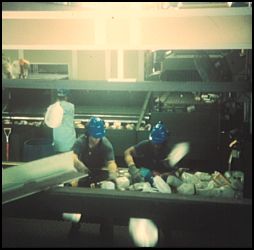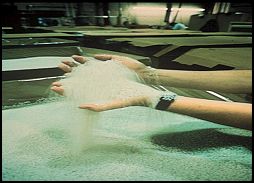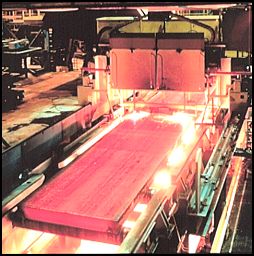Recycling Economic Information Study
June 2000 Study Highlights
Introduction
The Recycling Economic Information Study represents the most comprehensive examination to date of the economic activity generated by the region's recycling and re-use industry. This industry is both a model for resource conservation and efficient materials utilization, and, as documented in this Study, a key contributor to the region's economy. The study region was the ten states of the Northeast Recycling Council (NERC): Connecticut, Delaware, Maine, Massachusetts, New Hampshire, New Jersey, New York, Pennsylvania, Rhode Island, and Vermont.
Key Study Findings
The key findings of the Study for the NERC region are as follows:
- 13,000 recycling and reuse establishments,
- 206,000 employed in recycling and re-use industries,
- $6.8 billion in annual payroll, and
- $44 billion in annual revenues.
|
||||||||||||||
Industry Overview
The Study demonstrated that the region's recycling and re-use industries are highly diverse in the recovered materials utilized, the technologies employed, and the size of the establishments.
The Recycling Sector was divided into 19 distinct categories by type of establishment. These operations collect and process recovered materials and manufacture products using recycled materials. They include long-established sectors like paper and steel making, but also new entrepreneurial ventures such as composting, and plastic and rubber product manufacturing. There are over 8,000 recycling related establishments in the region. As Table 1 illustrates, the majority of establishments are involved in the early stages of the recycling loop, i.e., collection and processing. The manufacturers that use these recovered materials to produce finished products are fewer in number, but larger in size.
|
Table 1 Collectors: 3,417 total establishments
Processors: 2,494 total establishments
Manufacturers: 1,844 total establishments
Other
|
The Reuse & Remanufacturing Sector was divided into nine categories. These diverse establishments refurbish used, old or broken equipment. In the Study, it is conservatively estimated that there are over 5,000 re-use and remanufacturing establishments in the region (Due to resource constraints for the study, this figure does not include large sectors such as industrial equipment manufacturing). As Table 2 shows, these categories include operations that sell a wide range of used merchandise, as well as burgeoning categories such as establishments remanufacturing and marketing used computers and electronic appliances.
|
Table 2
|
The Region's Big Four
While the recycling and re-use industry is highly diversified, four types of establishments dominate in-terms of their contribution to the region's economy.
 Recyclable Material Wholesalers
Recyclable Material Wholesalers
These are operations such as paper stock dealers, scrap metal processors, and other establishments that sort, remove contaminants, and densify recovered materials. Recycling activities at recyclable material wholesalers:
- Employ more than 26,000 people,
- Generate annual payrolls of $760 million, and
- Result in $8.3 billion in annual revenue.
 Paper, Paperboard, & Deinked Market Pulp Mills
Paper, Paperboard, & Deinked Market Pulp Mills
These manufacturers produce paper and paperboard products from recovered paper or market pulp and/or deinked recovered paper and sell pulp. These mills use a wide range of waste paper to produce a variety of finished paper grades. Recycling activities at paper, paperboard and deinked market pulp mills:
- Employ more than 24,000 people,
- Generate annual payrolls of $1.08 billion, and
- Result in $6.9 billion in annual revenues.
 Plastic Converters
Plastic Converters
These companies convert a recycled plastic clean flake or pellet into an intermediate or end product. Compared to the other members of the big four, these facilities are a much newer addition to the region's recycling industry. Recycling activities at plastic converters:
- Employ more than 31,000 people,
- Generate annual payrolls of $880 million, and
- Result in $6.3 billion in annual revenue.
 Steel Mills
Steel Mills
These companies produce iron and steel slabs, billets, bar, plate, and sheet from scrap and/or raw materials. By all measures used in this Study, among recycling and reuse establishments steel mills are the most significant contributor to the region's economy. Recycling activities at steel mills:
- Employ more than 31,000 people,
- Generate annual payrolls of $1.5 billion, and
- Result in $10.4 billion in annual revenues.
- Cumulatively, the big four account for approximately
- 55 percent of all employees,
- 63 percent of total payroll, and
- 72 percent of total receipts
- of the recycling and re-use industries as a whole.
- The average payroll of $37,700 per employee for these four categories is 14 percent higher than the average of $33,000 for all categories.
- At 37, the average number of employees per establishment for the big four is also higher than the average number of employees for all categories of 16.
Recycling Manufacturers Compared to Manufacturing Base
The most commonly used measure of an industry's size is the number of individuals employed in that sector. Using conservative methods to estimate the amount of manufacturing employment directly attributable to recycling, it is estimated that 1,870 recycled product manufacturers employ 136,000 people, or approximately 4% of the overall manufacturing employment in the Northeast region.
Conclusion
The Recycling Economic Information Study demonstrates the significant contributions the recycling and re-use industry makes to the region's economy. The Study findings will be used by NERC and its member states as a baseline to track developments and changes in the industry in the future, and to effectively target economic and market development resources and programs to specific sectors of this expanding industry. The Study is the first phase of a national study being undertaken by the National Recycling Coalition (NRC) to measure the economic activity associated with the recycling and reuse industries throughout the country.
Download a copy of the report in PDF format here:
Recycling Economic Information Study Final Report (1.6MB)


